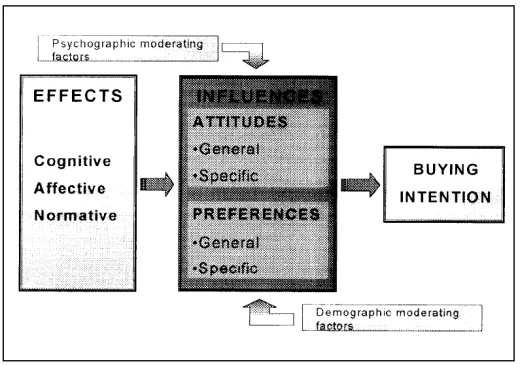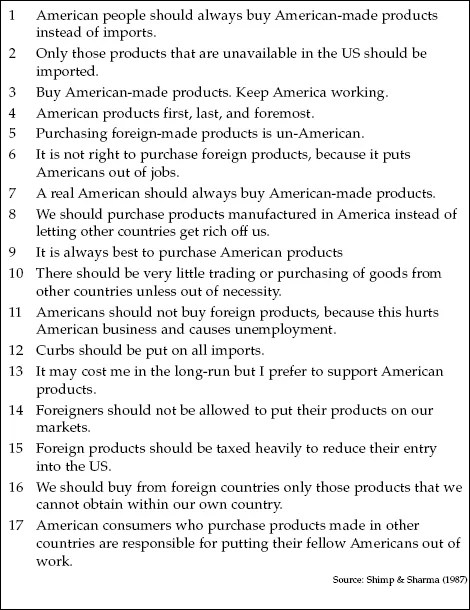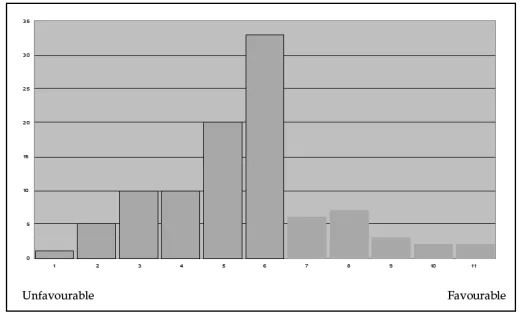![]()
1 Image and Spanish Country of Origin Effect
J. Enrique Bigné
Universitat Jaume I, Spain
Introduction
The aim of this paper is to analyse the ‘made in’ or country of origin effect. The first studies on the subject appeared in the 1970s and since then a lot of research papers have discussed both the existence and argued relevance of the country of origin as an identifiable selling feature. Peterson & Jolibert (1995) counted more than two hundred papers on the topic published in international journals and presented at conferences. This current study is based on the preliminary idea that the country of origin of a product is an extrinsic attribute that influences consumer assessment of that product.
Some argue that the country of origin has little impact on product selection while others believe that this additional attribute allows clearer differentiation between products (Bilkey & Nes, 1982; Papadopoulos & Heslop, 1993; Peterson & Jolibert, 1995). Nevertheless, there are certain features which influence the impact of the country of origin effect. These include increased trade flows; greater standardisation of products; closer economic integration exemplified by the European Union and Mercosur in South America; and more common international division of production, resulting in hybrid products (Ettenson & Gaeth, 1991). A new phenomenon has emerged: products are made in more than one country. This is the case of a personal computer whose parts are made in Taiwan, Indonesia, Malaysia or wherever, assembled in Germany, and sold, perhaps, in South America. These patterns work in favour of the importance of country of origin effect. In fact, the country of origin may be seen as a competitive advantage. In addition, some companies are now also using regional brands, like ‘Made in Europe’. This new general brand is critical for the country of origin effect.
Conceptual framework
A general conceptual framework of country of origin can be seen in Figure 1. Three different effects can be distinguished: cognitive, affective and normative. They can have an influence on attitudes and preferences, both generic and for specific product categories made in one country. These are moderated by demographic and psychographic factors, such as personality, values and lifestyle and can affect consumers’ buying intentions. Attitudes towards products made in one country involve an affective response involving positive or negative values, feelings or emotions triggered by the country or its products. Preference, on the other hand, reflects a choice between a number of options.
>Figure 1. Conceptual framework of the country of origin
Our review of the literature has shown a lot of empirical research on this subject. Much of it has focused on testing the influence of the country of origin effect on attitudes, at the level of brands (D’Asthous & Ahmed, 1993; Eroglu & Machleit, 1989; Wall, Liefeld & Heslop, 1991), product categories (Cicic, Tsai & Patterson, 1993; Cordell, 1992; Minor & Hodges, 1993; Miquel, Newman, Bigné & Chansarkar, 1993), industrial products (Cattin, Jolibert & Lohnes, 1982; Kaynak & Cavusgil, 1983; Kaynak & Kucukemiroglu, 1992; White & Cundiff, 1978), consumer products (Babb, Lascu & Vann, 1993; Bannister & Saunders, 1978) and even the influence of the retailer (Chao, 1989; Han & Terpstra, 1988). On the other hand, some research has focused on the influence of country of origin effect on preferences, both generic (Chao, 1989; Etzel & Walker, 1974; Kaynak & Cavusgil, 1983) and for specific industrial products (Cattin, Jolibert & Lohnes, 1982; Nagashima, 1977).
As well as empirical research, some efforts have been made to develop conceptual frameworks that explain the country of origin/made in effect construct. It is necessary to evaluate the importance of each of the three aspects: cognitive, affective and normative.
Figure 2. CETSCALE.
There are two approaches to the cognitive aspect: one is known as the halo approach (Ericksson, Johansson & Chao, 1984; Johansson, Douglas & Nonaka, 1985) and the other one is the summary (Han, 1989). Country of origin as a halo directly affects consumers’ beliefs about product attributes and indirectly affects overall evaluation of products through those beliefs:
country image → beliefs → brand attitude
and summary construct suggests the following relationships:
beliefs → country image → brand attitude.
For the affective aspect, two variables have been considered: beliefs (Ericksson, Johansson & Chao, 1984; Cordell, 1992) and attitudes (Han, 1989).
Finally a normative aspect, understood as the external and internal pressures on the consumer (Sharma, Shimp & Shin, 1995), has been more recently incorporated. This includes measuring ethnocentrism and the CETSCALE (Shimp & Sharma, 1987) which will be explained later.
The concept of ethnocentrism was originally developed in sociology almost a hundred years ago. Later, it was adapted to analysing consumer behaviour. As Shimp & Sharma (1987) pointed out, we can consider country of origin as a feature which influences beliefs held by consumers on the appropriateness, even the morality, of buying products made abroad. Shimp & Sharma (1987) measured this belief through a scale developed by them, known as the CETSCALE (Consumer Ethnocentrism Scale), plotting the responses to seventeen statements on a seven-point Likert scale. Figure 2 shows the scale proposed originally by Shimp & Sharma (1987).
Since then, only a few studies have been carried out using this scale in different cultures. Among them Netemeyer, Durvasula & Lichtenstein (1991) used it in Japan, the United States, Germany and France; Pecotich, Presley & Roth (1993) in Australia; and later Sharma, Shimp & Shin (1995) in Korea. No research has yet been carried out in a homogeneous cultural and socio-economic context such as the European Union. Sharma, Shimp & Shin (1995) also identified some moderating variables: some demographic and economic, such as gender, age, education and income, and some psychographic, like patriotism, cultural openness and perception of economic threat.
Objectives
Little research has been done on country of origin and consumer ethnocentrism at European level and even less in Spain. It was with this in mind that we carried out an empirical study in continuance of an earlier one, from 1991. Our current objectives are as follows.
Firstly, we want to study attitudes towards foreign products, and for some specific product categories made in Spain. As we discussed earlier, attitudes towards ‘made in’ as a product attribute are critical for later consumption.
Secondly, we aim to measure general and specific preferences towards product categories made in particular countries.
Thirdly, the appropriateness of buying products made abroad measured by the CETSCALE was investigated. This will lead to some explanations of consumers’ behaviour regarding the choice of foreign versus national products. For these purposes, we carried out an empirical study in four European countries: France, Germany, Spain and the UK. We selected five product categories of great impact on the Spanish economy: footwear, toys, tourist resorts, oranges and wine, widely recognised by consumers in each country.
Graph 1. Bar diagram of feelings about buying foreign products (percentages).
We used a personal interview to obtain information using the CETSCALE about individuals’ degree of openness to foreign issues, the degree of knowledge of other countries, the degree of familiarity with the products, scales of specific attitudes to product categories, specific preference for product categories and ethnocentrism beliefs. We obtained a sample of 176 German respondents, 450 Spaniards, 173 from France and 206 from the UK.
Analysis of results
A survey carried out by Gallup gave us some preliminary information: 20,000 respondents from 20 different countries participated in the Gallup survey (BozellGallup, 1994). In the worldwide survey, the most preferred countries were Japan, Germany, United States, United Kingdom and France. Within Europe: Germany, Japan, the United States, the UK and France were the most preferred countries.
In 1991, we undertook a study in Spain and the UK (Miquel, Bigné & Newman, 1993) from which we can conclude that:
| • | Spaniards preferred national products. |
| • | The British view of Spanish products was neutral. |
Table 1. Feelings about buying foreign products (% vertical)
| • | Spanish fruit and vegetables had a clearly differentiated image. |
| • | Spain has a low competitive position in wines, cars and toys. |
| • | There was a low knowledge of Spanish brands. |
| • | The best attributes for Spanish products were price, design and appearance. |
Generic attitude towards foreign products
In order to analyse the general attitude towards foreign products, a question was asked regarding feelings about buying products manufactured abroad. The response was scored from 1 (very unfavourable) to 11 (very favourable).
Graph 1 shows the distribution of frequencies for the whole sample. Distribution is normal, with higher peaking in average values.
Table 1 shows the distribution of frequencies. We have divided feelings into four quartiles. From the table we can deduce that the respondents who express the most negative feelings are the French and the British, the least negative feelings towards foreign products being expressed by Germans and Spaniards. The mean values also show the situation of each group of respondents.
The variance analysis of the attitude towards foreign products confirms the existence of significant differences between countries.
Attitudes towards specific product categories
In our current study, focused on specific attitudes towards some product categories, we have found that shoes made in Spain are perceived, on a scale from 1 to 7, as follows (mean scores in brackets):
For Germans, they have a good appearance (5.0), reasonable price (4.9) and modern design (4.9). French consumers considered that Spanish shoes have wide variety (5.3), give a satisfactory result (5.2), have a good appearance (5.0) and are for the lower classes. Spanish respondents thought that Spanish shoes have a good appearance (5.9), are reliable (5.7) and well finished (5.6). Amongst the British respondents, Spanish shoes obtained intermediate values and they only emphasise good appearance (4.7). To sum up, we can consider that good appearance is the key cue for Spanish shoes, useful in a fashion product category. Consequently the strategic promotion effort must be directed towards emphasising this external attribute of Spanish shoes. Hardly any negative attributes appear, except the French perception ‘of lower classes’, so prices must be aimed at offering good value for money in this market.
For Spanish toys we found that for Germans there is not a clear attitude except good appearance (4.6). French consumers considered that Spanish toys have good appearance (4.8), offer a wide variety (4.8) and give a satisfactory result (4.7). Spaniards view their own toys as having good appearance (5.8), wide variety (5.6), modern design (5.2) and high prices (5.2). Again in this product category, the British view of Spanish toys was neutral, like in Germany, so a great effort must be made to promote Spanish toys among British and German consumers by communicating their benefits. These markets are of great importance because their per capita expenditure on toys is higher than Spain’...




